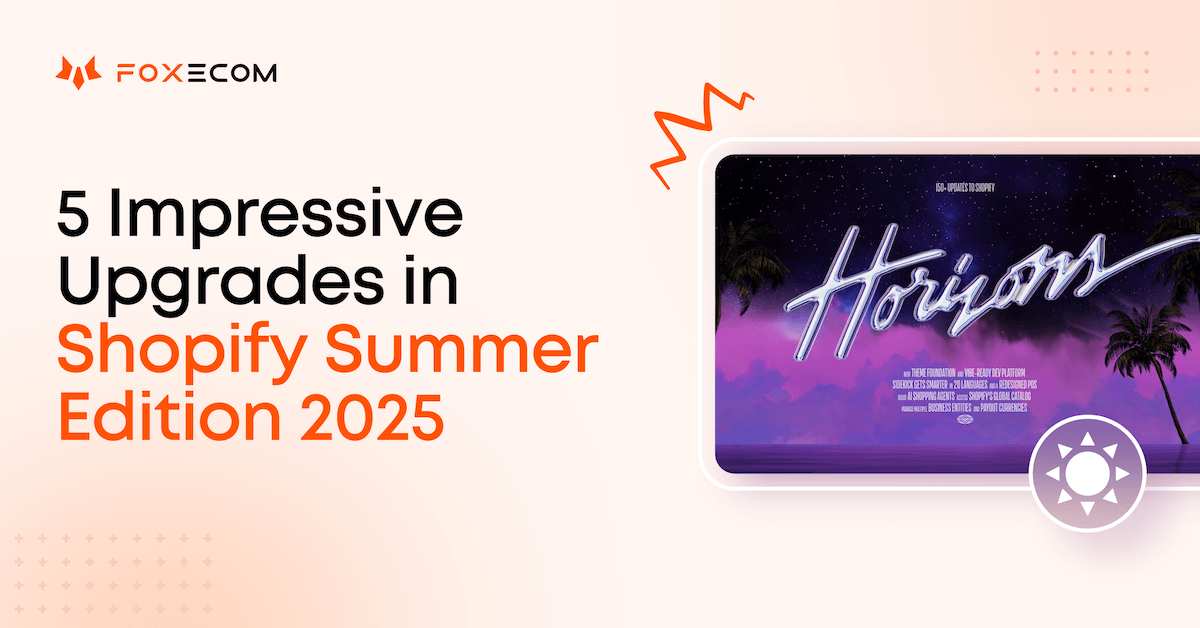Shopify has just released its Summer 25’ Edition, and it’s already making waves across the eCommerce world.
So, what’s causing all the buzz? In a word: AI.
From AI-generated storefronts to a more intelligent Sidekick assistant, global B2B enhancements, and a major POS overhaul, this Edition puts artificial intelligence and merchant experience at the heart of the Shopify platform.
But what does this shift really mean for merchants, developers, and eCommerce teams navigating the platform today?
In this breakdown, we’ll walk through the 5 most impactful upgrades from Shopify Summer Edition 2025, how they’re reshaping the way merchants build and scale, what’s still missing, and what might be just around the corner.
👉 Curious how Shopify stacks up overall? Read our full Shopify review
What Are 5 Impressive Upgrades from Shopify Summer ‘25 Edition?
1. New design era: AI + New themes are a game-changer
Shopify is reimagining storefront design with a powerful combination of AI-driven tools and next-gen theme architecture - and it all starts with Horizon.
The newly introduced Horizon theme comes with 10 ready-to-use design presets, positioned as Shopify’s new design foundation. Each preset is clean, conversion-focused, and optimized for speed - perfect for lean teams and first-time merchants.

10 presets for the Horizon theme
Horizon also harnesses the full power of theme blocks, allowing users to:
- Start with beautifully crafted presets
- Customize every section from the ground up with total layout flexibility.
AI-powered tools that build for you:
What sets Shopify Summer 25’ edition apart is the leap in AI-assisted design:
-
AI Theme Generator: Instantly builds entire page layouts from simple prompts.
-
AI Block Generator: Intelligently suggests and assembles design sections based on your needs.
-
Revamped Theme Editor: Now includes 30+ modular content blocks, offering unmatched control, all within Shopify’s native builder.
Together, these tools enable merchants to design, launch, and iterate faster than ever, without needing a developer or designer, for most basic-to-intermediate needs.
📚 How merchants benefit from these new upgrades:
-
Lower barriers, greater accessibility: AI removes technical friction, empowering anyone to create polished storefronts -no coding required.
-
Cost savings: For small-to-medium stores, this reduces the need for third-party page builders or design services.
-
Faster time to launch: The Horizon presets are highly usable out of the box, ideal for lean or fast-moving teams.
That said, some may find them more visually cohesive than structurally diverse.
While Horizon and Shopify’s AI tools are a huge win for agility and ease of use, they’re best suited for small-to-medium catalogs or early-stage brands. For larger stores with complex product structures or custom merchandising needs, premium themes like Sleek or Hyper, or a page builder app like Foxify, still offer greater control and scalability.
💡The bigger message for themes and app developers:
This is more than just a theme release - it’s a strategic shift. Shopify is giving more power directly to merchants. If you’re building in the Shopify ecosystem, the priority is clear: Focus on flexibility, user-friendliness, and built-in intelligence to stay relevant in an AI-first future.
2. Meet Sidekick: From assistant to essential business partner
Shopify's Sidekick has officially evolved - from a helpful chatbot to a powerful virtual business partner designed to simplify operations, boost productivity, and offer real-time support for merchants of all sizes.
With the Shopify Summer 25’ Edition, Sidekick becomes significantly more intelligent, interactive, and deeply integrated into merchants’ workflows.
What’s new in Sidekick?
-
Smarter reasoning engine
Sidekick can now analyze your store’s data to help identify the root causes of issues, from declining conversion rates to abandoned carts. It doesn't just flag problems - it explains why they’re happening and suggests actionable fixes.
-
Voice chat + screen sharing
Merchants can now speak directly to Sidekick and share their screen for collaborative troubleshooting. It's like having a live customer success manager - available on demand, 24/7.
-
Free AI image generation
Need product imagery or campaign visuals in a pinch? Sidekick now integrates AI-powered image generation, allowing you to create custom visuals without expensive design tools or outsourcing.
-
Multilingual support: Now in 20 languages
Shopify continues to broaden its global reach. Sidekick is now fluent in 20+ languages, helping merchants communicate, build, and troubleshoot in their native tongue.
How merchants benefit from Sidekick
-
Real-time problem solving
Whether it's optimizing your homepage layout or diagnosing a dip in sales, Sidekick is ready to guide you through fixes, with context from your actual store data.
-
Faster decision-making
With a smarter reasoning engine, Sidekick helps merchants make informed, confident decisions without switching between tools or digging through reports.
-
Lower operational overhead
From generating images to providing instant support, Sidekick reduces the need for extra staff, freelancers, or external consultants.
-
More inclusive and accessible
With multilingual capabilities, merchants across different regions can now fully leverage Sidekick’s potential - no translation or workaround needed.
What’s next?
Shopify is clearly positioning Sidekick as the AI core of the platform, not just a helper. Expect future editions to bring:
- Deeper integrations with apps and analytics tools
- More proactive suggestions (e.g., sales campaigns, product restocks)
- Expanded creative capabilities across design and marketing
Sidekick is no longer a “nice to have” - it’s becoming the operational backbone for modern Shopify stores.
3. Redesigned Shopify POS: Smarter, faster, and built for omnichannel
Shopify has overhauled its Point of Sale (POS) system in the Summer 25’ Edition, with a clear focus on creating a seamless, unified experience for merchants who sell both online and in physical stores.
The update reflects Shopify’s commitment to omnichannel retail, giving merchants the tools to manage staff, serve customers, and process orders - whether on the sales floor or from a mobile device.
What’s new in the Shopify POS update?
-
Streamlined, retail-first user interface
The new POS design is cleaner, faster, and easier to navigate, especially for staff using tablets or mobile devices in real time.
-
Smarter staff permissions
Merchants can now assign more granular access controls, making it easier to manage roles, reduce errors, and ensure secure operations across store locations.
-
Improved checkout flows
Enhancements to speed, layout, and payment processing help staff serve customers faster, with fewer taps and fewer steps.
-
Mobile-first designs
The system is now more intuitive for smartphones and tablets, allowing store associates to move freely on the floor and still process orders efficiently.
How does this help merchants?
- Better in-store experience for customers and staff alike
- Easier training and fewer mistakes, thanks to a simplified UI
- Supports hybrid selling models, making the transition between online and in-store smoother
- Future-proof retail operations, especially for businesses expanding to pop-ups or multi-location setups
What our experts predict: Shopify is doubling down on retail
As omnichannel commerce continues to rise, Shopify’s POS revamp positions it as a serious player in the retail tech space, especially for SMBs looking for a unified commerce system.
By combining online storefronts, inventory, and physical checkout into one platform, Shopify is making it easier than ever for brands to scale their retail presence without fragmented tools.
This Summer 25’ Edition is more than just polish, it’s part of a broader strategy to solidify Shopify’s role as the go-to solution for modern, agile retailers.
4. Faster Checkout, Expanded Shopify Payments, and New-rule Refunds
In the Shopify Summer Edition 2025, checkout, payment, and refund processes are getting a significant upgrade, focus on removing friction, reducing hidden costs, and giving merchants more control over the post-purchase experience.
What’s new in Checkout & Payments?
-
Shopify Payments expanded to 16 new countries
Shopify’s native payment gateway is now available in more regions, for example, including Mexico, Greece, and Poland, and more, giving merchants access to faster payouts, lower transaction fees, and seamless global selling, without third-party integrations.

Shopify payment in 16 more countries
-
2-second faster checkout
Shopify has optimized its checkout engine to be even quicker. A faster checkout means lower abandonment rates and a smoother buying journey, especially on mobile.
-
Flat rates for split shipping
Merchants can now charge customers one flat shipping rate, even when fulfilling orders from multiple locations. This reduces unexpected shipping fees at checkout, which is a common cause of cart drop-off.

Flat rate for split shipping
-
Refunds as store credit
Instead of issuing cash refunds, merchants can now offer store credit—a smart way to retain revenue and encourage repeat purchases.

Refund as store credit
Why this matters
Shopify is continuing its push to become the default checkout for the internet, and these updates show that it's listening closely to what merchants and customers need.
Whether you’re scaling internationally, managing multi-location fulfillment, or simply trying to boost repeat purchases, Shopify’s latest checkout upgrades are built to make commerce easier - and more profitable.
5. B2B Boost: Market Expansion and Compliance Tools
With Shopify Summer Edition 2025, B2B sellers get a serious upgrade, bringing the platform closer than ever to parity with dedicated B2B eCommerce solutions. These updates are designed to help merchants streamline wholesale operations, expand into new markets, and stay compliant with regional tax regulations.
What’s new for B2B merchants?

Shopify for B2B updates
-
Markets now supports B2B customers
Shopify Markets, originally built for DTC expansion, now supports localized selling for wholesale buyers, enabling merchants to tailor pricing, currencies, and domains specifically for B2B audiences.
-
EU & UK VAT number validation
Through Shopify Tax, merchants can now validate VAT numbers directly in the admin. This reduces compliance risk and automatically applies tax exemptions for qualified buyers, especially important for businesses selling across the EU and UK.
-
Min/max order value settings
With the Checkout Blocks app, merchants can now set minimum and maximum order thresholds - a core B2B function that helps enforce volume-based buying policies and operational efficiency.
Where Shopify is heading for B2B
Shopify is steadily closing the gap with platforms like BigCommerce B2B and Adobe Commerce, which traditionally led the B2B space. These 2025 updates lay the groundwork for more advanced B2B features expected in future Editions - like:
-
Bulk pricing and tiered discounts
-
Account portals for self-serve reordering
-
ERP and inventory management integrations
The message is clear: Shopify is no longer just for DTC brands. It’s becoming a serious contender in the wholesale and B2B commerce space, especially for merchants who want to run DTC and B2B under one roof.
What’s Still Missing? Expectations from the Community
Even with impressive improvements in AI, design, and B2B functionality, merchants and developers still have a few ongoing pain points and open expectations.
1. Product variant limits remain a bottleneck
Despite platform-wide innovation, Shopify still caps variants at 100 per product. This continues to be a limiting factor for brands in fashion, electronics, accessories, and other industries with complex product configurations. Merchants are still looking for more flexible, scalable solutions natively, without relying on workarounds or third-party apps.
2. New themes are clean, but still basic
Horizon is fast and user-friendly, but it caters primarily to small-to-mid-size catalogs. Although with the support of AI, you still need time to design on your own. For stores with high-SKU complexity, advanced visual merchandising, or detailed category structures, using paid themes and page builders is still saving time and helps your stores become more organized.
How Has Shopify Edition Evolved: 2024 Editions vs. Summer 2025?
To understand how far Shopify has come in just one year, let’s compare the key highlights from the 2024 Editions (Summer + Winter) with what’s been introduced in Summer 2025.
|
Category |
2024 Editions (Summer + Winter) |
2025 Summer Edition |
|
AI & Sidekick |
Sidekick beta + Shopify Magic for copy |
Sidekick upgraded with voice chat, screen share, reasoning, and 20+ languages |
|
Store design |
Sections API improvements, dev-focused customization |
AI Theme Generator + AI Block Creation, 10 free presets, 30+ flexible content blocks |
|
Themes |
Basic customization, still dev-reliant |
DIY-friendly, AI-assisted themes for lean teams |
|
Checkout & Payments |
Checkout extensibility, stackable discounts |
Shopify Payments in 16 more countries, store credit refunds, and flat shipping rates |
|
POS tools |
UI tweaks, staff roles, smart grid |
Full POS redesign, faster checkout, mobile-first |
|
B2B capabilities |
Catalogs, price lists, payment terms, customer-specific storefronts |
VAT validation, min/max order limits, and Markets support for B2B |
|
Performance tools |
Shopify Magic for SEO, backend optimizations |
Shift to UX & cost-saving tools built into the platform |
|
Developer |
Expanded Functions, App Bridge, checkout APIs |
No major dev updates-focus on merchant-facing features |
Prediction: What Are Shopify’s Next Steps?
Based on this direction, here’s what we expect from the upcoming Shopify Editions:
-
AI will go deeper into core business operations, helping with product sourcing, demand forecasting, and even customer support.
-
B2B could receive portal-level upgrades next, enabling bulk reorders, account dashboards, and deeper ERP sync.
-
More 3rd-party app functionality may be absorbed natively, as Shopify continues to simplify workflows and reduce dependency on external tools.
The Shopify Summer Edition 2025 represents a major shift toward merchant independence, speed, and intelligence, powered by AI and streamlined UX.
It’s a strong year for:
- New brands are building lean
- SMBs scaling across borders
- Teams wanting to do more without dev overhead
But it’s also a wake-up call for developers, theme creators, and app builders: Shopify is giving merchants more tools out of the box, so the future is about adding deeper value, not just filling feature gaps.
Want more ecommerce insights, tutorials, and Shopify strategies? Explore our eCommerce blog.





